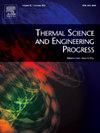基于响应面法的混合纳米流体循环换热器换热优化
IF 5.1
3区 工程技术
Q2 ENERGY & FUELS
引用次数: 0
摘要
关于自然对流的研究很多,但关于磁场、辐射和混合纳米流体在圆形空间中的影响的研究不多。这就是为什么这项研究使用先进的计算和统计方法来提高传热性能。本研究的目的是探讨在磁场和辐射作用下圆形腔内自由对流的灵敏度。这个空腔还包含四种不同形状的加热障碍物,淹没在混合纳米流体中。灵敏度分析采用Minitab软件进行,计算仿真采用COMSOL Multiphysics软件基于有限元法的Galerkin加权残差法进行。本研究考察了四个非量纲变量的影响:Ra, Rd, Ha,以及np。在数值水平上,Nuav与Ra和Rd之间呈上升趋势,而与Ha之间呈下降趋势。Ra从103增加到106时,Nuav增加了近3.5倍(342.53%),Rd参数从0增加到1时,Nuav增加了100.80%。另一方面,Nuav下降36.31%,Ha上升0 ~ 40。对现有模型和测试方法的统计分析表明,响应函数的R2值有所提高。(99.19%),证实该模型适用于评价Nuav。该研究结果将为热能储存系统、先进电子冷却技术以及在MHD和辐射影响下使用混合纳米流体的太阳能集热器的设计优化等领域的研究人员、设计师和学者提供有益的参考。本文章由计算机程序翻译,如有差异,请以英文原文为准。
Optimizing heat transfer in circular heat exchanger with hybrid nanofluid using response surface methodology
There has been a lot of research on natural convection, but not much on the effects of magnetic fields, radiation, and hybrid nanofluids in circular spaces. That’s why this study uses advanced computational and statistical methods to improve heat transfer performance. The goal of this study is to look into the sensitivity regarding a free convection in a round cavity with a magnetic field along with radiation effect. This cavity also contains four different shapes of heated obstacles, submerged within a hybrid nanofluid. Sensitivity analysis was performed using response surface methodology (RSM) which is conducted by Minitab software, while computational simulations are conducted using the Galerkin weighted residual method based on Finite Element Method (FEM) by COMSOL Multiphysics. This study examines the impacts of four nondimensional variables: Ra, Rd, Ha, also ϕnp. An upward trend was identified at the numerical level between the Nuav with Ra and Rd, although a declining trend is present with Ha. Moreover, Nuav increases by almost a three and half times (342.53%) when Ra increases from 103 to 106 and increases 100.80% when Rd parameter increases from 0 to 1. On the other hand, Nuav decreases by 36.31% while Ha rises 0 to 40. The statistical analysis of the existing model and testing methodologies indicates that the R2 values for the response function are elevated. (99.19%), confirming that this model is suitable for evaluating Nuav. The results of this study will be benefited for the researchers, designers and academicians in the field of thermal energy storage systems, advanced electronic cooling technologies, and design optimization of solar collectors using hybrid nanofluids under MHD and radiation influences.
求助全文
通过发布文献求助,成功后即可免费获取论文全文。
去求助
来源期刊

Thermal Science and Engineering Progress
Chemical Engineering-Fluid Flow and Transfer Processes
CiteScore
7.20
自引率
10.40%
发文量
327
审稿时长
41 days
期刊介绍:
Thermal Science and Engineering Progress (TSEP) publishes original, high-quality research articles that span activities ranging from fundamental scientific research and discussion of the more controversial thermodynamic theories, to developments in thermal engineering that are in many instances examples of the way scientists and engineers are addressing the challenges facing a growing population – smart cities and global warming – maximising thermodynamic efficiencies and minimising all heat losses. It is intended that these will be of current relevance and interest to industry, academia and other practitioners. It is evident that many specialised journals in thermal and, to some extent, in fluid disciplines tend to focus on topics that can be classified as fundamental in nature, or are ‘applied’ and near-market. Thermal Science and Engineering Progress will bridge the gap between these two areas, allowing authors to make an easy choice, should they or a journal editor feel that their papers are ‘out of scope’ when considering other journals. The range of topics covered by Thermal Science and Engineering Progress addresses the rapid rate of development being made in thermal transfer processes as they affect traditional fields, and important growth in the topical research areas of aerospace, thermal biological and medical systems, electronics and nano-technologies, renewable energy systems, food production (including agriculture), and the need to minimise man-made thermal impacts on climate change. Review articles on appropriate topics for TSEP are encouraged, although until TSEP is fully established, these will be limited in number. Before submitting such articles, please contact one of the Editors, or a member of the Editorial Advisory Board with an outline of your proposal and your expertise in the area of your review.
 求助内容:
求助内容: 应助结果提醒方式:
应助结果提醒方式:


